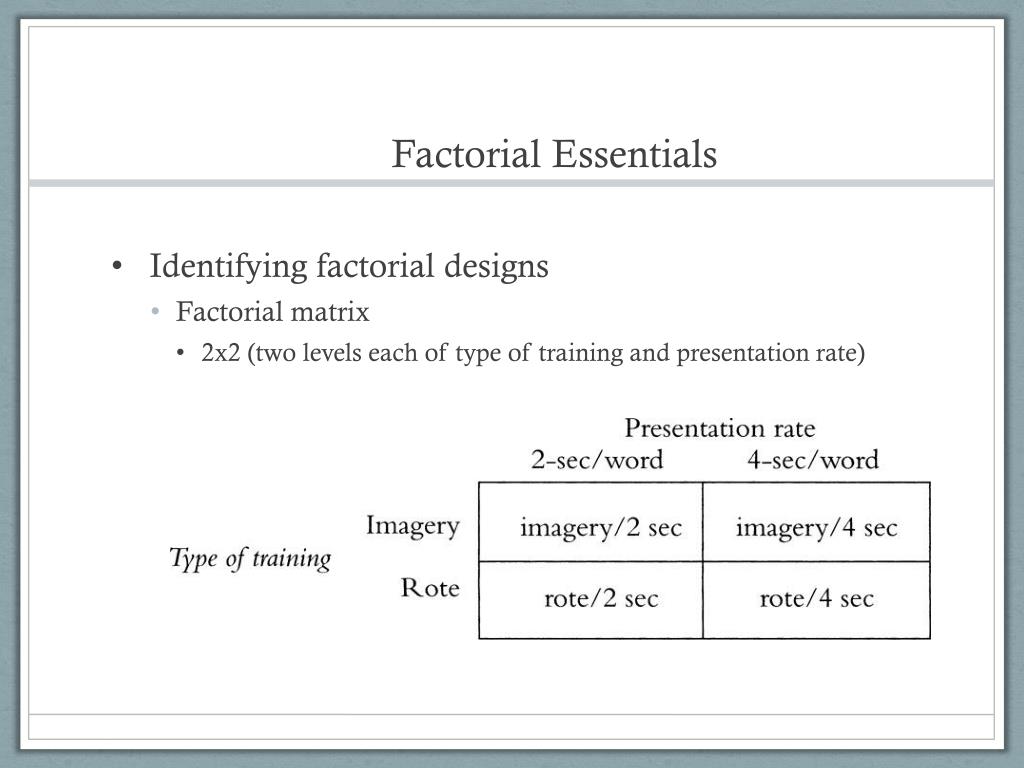
The within-subjects design is more efficient for the researcher and controls extraneous participant variables. In sum, unless the investigator has access to clearly relevant data (preferably from factorial experiments) s/he should have strong concerns about how the elements in a treatment (the ICs) might interact. Only factorial designs permit efficient screening of multiple ICs or dimensions (e.g., length of treatment), revealing their main effects and interactions and permitting the identification of those that are compatible or most promising (Collins et al., 2016).
Differences between factorial experiments and RCTs

The third factor is an adherence factor (i.e., an automated medication counter with counseling, on/off). Thus, this experiment would address which type of NRT exerts additive or interactive effects when used with varenicline, and whether the adherence intervention exerts main or interactive effects. Obviously the investigator must make the intervention relevant to each medication type, but such adjustment raises questions. Is the adherence intervention different enough in its various forms (across medications) so that it no longer constitutes a single, coherent component? If that is true, its effects cannot be interpreted in a straightforward manner.
Factorial Designs
The shelves are ‘blocks’, which are collections of experimental units that are similar in traits (e.g., light level) that might affect the experimental outcome1. A ‘run’ is the execution of a single experimental unit, and the ‘sample size’ is the number of runs in the experiment. If a researcher is curious about a topic, such as people’s food preferences, they may consider a factorial analysis design—an experimental approach used when examining the effects of more than one factor, at least two independent variables, on one dependent variable. Factorial design is a type of research methodology that allows for the investigation of the main and interaction effects between two or more independent variables and on one or more outcome variable(s).
Minitab Example for Centrifugal Contactor Analysis
By randomly selecting participants and using statistical techniques to analyze the data, researchers can make inferences about the larger population with a high degree of confidence. In this design, the researcher manipulates one or more variables at different levels and uses a randomized block design to control for other variables. Now let’s consider the main effect of a different factor, increasing physical activity.
Analyzing DOE Results
Optimization of ICP-MS internal standardization for 26 elements by factorial design experiment - ScienceDirect.com
Optimization of ICP-MS internal standardization for 26 elements by factorial design experiment.
Posted: Sun, 23 Apr 2023 08:02:46 GMT [source]
They are simple to design and analyze, while providing information that can be used to inform more detailed follow-up experiments using only the factors found to be important. More details on full and fractional factorial designs can be found in ref. 4. We can apply the same reasoning in a 26 experiment to remove half the runs. In the 32-run 26–1 fractional factorial design there are 32 confounding relations (e.g., ABCDEF with the intercept, A with BCDEF, etc.), and, importantly, all of the main effects and two-factor interactions are confounded with four- and five-factor interactions. Given our assumption that these high-order effects are unlikely to be important, we have little worry that they will contaminate our estimate of the main effects and two-factor interactions. Higher order interactions can reflect complex patterns that defy easy interpretation.
2: Design of experiments via factorial designs
However, the number of experimental runs required for three-level (or more) factorial designs will be considerably greater than for their two-level counterparts. Factorial designs are therefore less attractive if a researcher wishes to consider more than two levels. As a further example, the effects of three input variables can be evaluated in eight experimental conditions shown as the corners of a cube. When we use a 2×2 factorial design, we often graph the means to gain a better understanding of the effects that the independent variables have on the dependent variable. Due to its flexibility and practicality, factorial analysis continues to be one of the most common experimental designs used across all disciplines. A recent study, for instance, investigated whether consumer behavior may depend on whether the product is utilitarian or hedonic.

Types of Factorial Design
All participants could be tested both while using a cell phone and while not using a cell phone and both during the day and during the night. This would mean that each participant would need to be tested in all four conditions. The advantages and disadvantages of these two approaches are the same as those discussed in Chapter 5. The between-subjects design is conceptually simpler, avoids order/carryover effects, and minimizes the time and effort of each participant.
Medium optimization for biomass production of three peat moss (Sphagnum L.) species using fractional factorial design ... - ScienceDirect.com
Medium optimization for biomass production of three peat moss (Sphagnum L.) species using fractional factorial design ....
Posted: Tue, 01 Jun 2021 19:44:48 GMT [source]
Analysis
When taking a general linear model approach to the analysis of data from RCTs and factorial experiments, analysts must decide how to code categorical independent variables. This problem is avoided if an analysis of variance package is used, because such packages typically default to effect coding. However, as noted by Kugler et al. (Kugler, Trail, Dziak, & Collins, 2012), in regression analyses investigators may use either dummy coding (also known as reference cell coding) or effect coding (also known as unweighted effects coding) (cf. Cohen, Cohen, West, & Aiken, 2003). In dummy coding, a binary variable, a reference group (e.g., a control group) is assigned a value of zero (0) and the other group (e.g., an active treatment group) is assigned a value of one (1). Effect coding of a binary variable is the same except that the zero for the reference group is replaced with −1. In many factorial designs, one of the independent variables is a non-manipulated independent variable.
The additional complication is the fact that more than one trial/replication is required for accuracy, so this requires adding up each sub-effect (e.g adding up the three trials of a1b1). By adding up the coefficient effects with the sub-effects (multiply coefficient with sub-effect), a total factorial effect can be found. This value will determine if the factor has a significant effect on the outcome. For larger numbers, the factor can be considered extremely important and for smaller numbers, the factor can be considered less important. The sign of the number also has a direct correlation to the effect being positive or negative.
Using this design, all the possible combinations of factor levels can be investigated in each replication. Although several factors can affect the variable being studied in factorial experiments, this design specifically aims to identify the main effects and the interaction effects among the different factors. A 2×2 factorial design is a type of experimental design that allows researchers to understand the effects of two independent variables (each with two levels) on a single dependent variable. Ambitious, multifactor, factorial experiments designed to evaluate clinical ICs can and do work for the purpose of intervention component screening (Baker et al., 2016; Collins et al., 2016; Collins, Murphy, & Strecher, 2007; Fraser et al., 2014).
The graphs below illustrate no change in the percentage of seizures for all factors, so you can conclude that the chance of suffering from a seizure is not affected by the dosage of the drug or the age of the patient. When compared to the one-factor-at-a-time design (OFAT), factorial designs are less expensive, more efficient, and produce more comprehensive results. The columns for AB, AC and BC represent the corresponding two-factor interactions. The columns for A, B and C represent the corresponding main effects, as the entries in each column depend only on the level of the corresponding factor. For example, the entries in the B column follow the same pattern as the middle component of "cell", as can be seen by sorting on B. In the 2 × 3 example above, the degrees of freedom for the two main effects and the interaction — the number of columns for each — are 1, 2 and 2, respectively.
If a quadratic effect is expected for a factor, a more complicated experiment should be used, such as a central composite design. Optimization of factors that could have quadratic effects is the primary goal of response surface methodology. Returning to our example, suppose we wish to obtain a precise estimate of our drug’s effect on the mean response. If we expect that the effect is linear (our model has one parameter of interest, β1, which is the slope), the D-optimal design places either four or five experimental units in each block at the low level (0 ng/ml) and the remaining units at the high level (100 ng/ml).
The factors that have significant effects are shown in red and the ones without significant effects are shown in black. The further a factor is from the blue line, the more significant effect it has on the corresponding response. For wt% methanol in biodiesel, RPM is further from the blue line than pressure, which indicates that RPM has a more significant effect on wt% methanol in biodiesel than pressure does. The Pareto charts show which factors have statistically significant effects on the responses. As seen in the above plots, RPM has significant effects for both responses and pressure has a statistically significant effect on wt% methanol in biodiesel. Neither flow rate or ratio have statistically significant effects on either response.
Two-level factorial experiments, in which all combinations of multiple factor levels are used, efficiently estimate factor effects and detect interactions—desirable statistical qualities that can provide deep insight into a system. This gives them an edge over the widely used one-factor-at-a-time experimental approach, which is statistically inefficient and unable to detect interactions because it sequentially varies each factor individually while all the others are held constant. It is important to note that interpretation of complex higher order interactions may not be aided by simple effects testing. First, it is highly unlikely that such testing would have distinguished amongst the three leading combinations shown in Figure 1 (the differences in outcomes are too small).
The example experiment above would be described as a two-way factorial ANOVA, because it involves two independent variables. In respect to the number of levels considered for salary (low, moderate, and high) and skill sets (entry level and experienced), this same experiment is also designated as a 3 by 2 design, formally written as a 3 x 2 Factorial ANOVA. Of note, computing the product of 3 and 2 signifies that there is a total of 6 combinations of experimental conditions observed.
It involves carefully designing an experiment that can test the hypothesis, and controlling for other variables that may influence the results. Investigators may wish to adjust ICs to enhance their compatibility with other components. For instance, investigators might choose to reduce the burden of an IC by cutting sessions or contact times. This might reduce the meaning of the factor because it might make the IC unnecessarily ineffective or unrepresentative. From this table, we can see that there is positive correlation for factors A and C, meaning that more sleep and more studying leads to a better test grade in the class. Factor B, however, has a negative effect, which means that spending time with your significant other leads to a worse test score.

No comments:
Post a Comment